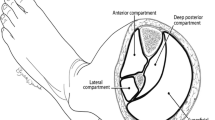Summary
In this study we present our experiences with the reverse sural fasciocutaneous flap to reconstruct the distal lower limb soft tissue defects caused by traumatic injuries. These flap graftings were carried out from Oct. 2010 to Dec. 2012 in our department. The series consisted of 36 patients, including 21 men and 15 women with an average age of 46.2 years (14–83 years) and with a medium follow-up period of 18 months (12–24 months). Of all the cases of acute trauma, there were 10 cases of trauma of distal tibia, 9 cases of trauma of perimalleolus, and 17 cases of trauma of midfoot and forefoot. Related risk factors in the patients were diabetes (2 cases), advanced age (>65 years, 3 cases) and cigarette smoking (6 cases). The reverse flow sural island flap irrigation depended on lower perforators of the peroneal artery. The fasciocutaneous pedicle was 3–4 cm in width and the anatomical structures consisted of the superficial and deep fascia, the sural nerve, short saphenous vein, superficial sural artery together with an islet of subcutaneous cellular tissue and skin. The most proximal border of the flap was only 1.5 cm away from the popliteal skin crease and the pivot point was 5–7 cm above the tip of the lateral malleolus. All the flaps survived. No arterial crisis occurred in any case. The venous congestion occurred in 2 cases and got better after raising the limbs and bloodletting. Only in an old man, 1.5 cm necrosis of distal margin of his flap occurred and finally healed after continuous dressing change. One-stage skin grafting was performed, and all the donor sites were sutured and successfully healed. It was concluded that the reverse sural fasciocutaneous flap is safe and reliable to extend to the proximal third even near the popliteal skin crease. We also concluded this flap can be safely and efficiently used to treat patients with large and far soft-tissue defects from the distal leg to the forefoot with more versatility and it is easier to reach the recipient sites.
Similar content being viewed by others
References
Keeling JJ, Hsu JR, Shawen SB, et al. Strategies for managing massive defects of the foot in high-energy combat injuries of the lower extremity. Foot Ankle Clin, 2010, 15(1):139–149
Rios-Luna A, Fahandezh-Saddi H, Villanueva-Martínez M, et al. Pearls and tips in coverage of the tibia after a high energy trauma. Indian J Orthop, 2008, 42(4):387–394
Tintle SM, Gwinn DE, Andersen RC, et al. Soft tissue coverage of combat wounds. J Surg Orthop Adv, 2010, 19(1):29–34
Wang X, Mei J, Pan J, et al. Reconstruction of distal limb defects with the free medial sural artery perforator flap. Plast Reconstr Surg, 2013, 131(1):95–105
Masquelet AC, Romana MC, Wolf G. Skin island flaps supplied by the vascular axis of the sensitive superficial nerves: anatomic study and clinical experience in the leg. Plast Reconstr Surg, 1992, 89(6):1115–1121
Schmidt K, Jakubietz M, Harenberg P, et al. The distally based dipofascial sural artery flap for the reconstruction of distal lower extremity defects. Oper Orthop Traumatol, 2013, 25(2):162–169
Yang C, Li Y, Geng S, et al. Modified distally based sural adipofascial flap for reconstructing of leg and ankle. ANZ J Surg, 2013, 83(12):954–958
van Waes OJ, Halm JA, Vermeulen J, et al. “The Practical Perforator Flap”: the sural artery flap for lower extremity soft tissue reconstruction in wounds of war. Eur J Orthop Surg Traumatol, 2013, 23Suppl 2:S285–289
Kececi Y, Sir E. Increasing versatility of the distally based sural flap. J Foot Ankle Surg, 2012, 51(5):583–587
Liu L, Zou L, Li Z, et al. The extended distally based sural neurocutaneous flap for foot and ankle reconstruction: a retrospective review of 10 years of experience. Ann Plast Surg, 2012 Dec 13 [Epub ahead of print]
Singh S, Naasan A. Use of distally based superficial sural island artery flaps in acute open fractures of the lower leg. Ann Plast Surg, 2001, 47(5):505–510
Benito-Ruiz J, Yoon T, Guisantes-Pintos E, et al. Reconstruction of soft-tissue defects of the heel with local fasciocutaneous flaps. Ann Plast Surg, 2004, 52(4): 380–384
Tu YK, Ueng SW, Yeh WL, et al. Reconstruction of ankle and heel defects by a modified wide-base reverse sural flap. J Trauma, 1999, 47(1): 82–88
Ríos-Luna A, Villanueva-Martínez M, Fahandezh-Saddi H, et al. Versatility of the sural fasciocutaneous flap in coverage defects of the lower limb. Injury, 2007, 38(7): 824–831
Price MF, Capizzi PJ, Watterson PA, et al. Reverse sural artery flap: caveats for success. Ann Plast Sur, 2002, 48(5): 496–504
Hassanpour SE, Mohammadkhah N, Arasteh E. Is it safe to extract the reverse sural artery flap from the proximal third of the leg? Arch Iran Med, 2008, 11(2):179–185
Hyakusoku H, Tonegawa H, Funiiri M. Heel coverage with a T-shaped distally based sural island fasciocutane ous flap. Plast Resconstr Surg, 1994, 93(4):872–876
Weng X, Li X, Ning J, et al. Experience of 56 patients using a retrograde sural neurovascular flap to repair lower limb tissue defects. J Plast Surg Hand Surg, 2012, 46(6):434–437
Li X, Li J, Wang P, et al. Clinical application of distally based sural neurovascular flap with preserved sural nerve and anastomosed lesser saphenous vein. Orthop J Chin, 2005, 13(18):1437–1438
Wang Y, Tian H, Zhu Q, et al. The clinical application of a nervus saphenus neurotrophy flap with reserved saphenous nerve. Chin J Microsurg, 2007, 30(6): 451–453
Noack N, Hartmann B, Küntscher MV. Measures to prevent complications of distally based neurovascular sural flaps. Ann Plast Surg, 2006, 57(1):37–40
Baumeister SP, Spierer R, Erdmann D, et al. A realistic complication analysis of 70 sural artery flaps in a multimorbid patient group. Plast Reconstr Surg, 2003, 112(1): 129–140
Author information
Authors and Affiliations
Corresponding author
Rights and permissions
About this article
Cite this article
Pan, Ht., Zheng, Qx., Yang, Sh. et al. Versatility of reverse sural fasciocutaneous flap for reconstruction of distal lower limb soft tissue defects. J. Huazhong Univ. Sci. Technol. [Med. Sci.] 34, 382–386 (2014). https://doi.org/10.1007/s11596-014-1287-z
Received:
Revised:
Published:
Issue Date:
DOI: https://doi.org/10.1007/s11596-014-1287-z




